Measuring employee engagement ROI: To do or not to do?
Employee engagement is the new gold standard that determines whether your organization is worthy of working for or not. Billions are being invested by companies of all sizes to keep their employees “working happily”.
Every weekend, every month, every year, HRs implement one or the other engagement initiative to ensure employees that the organization cares. Indeed, employees across the globe are well aware that their organization is putting tremendous efforts and thought into building a healthier work environment. However, the real concern is how much impact these efforts are producing.
Are you, as an HR, often being asked to measure or prove the ROI of your employee engagement plan? If yes, read on. We will be touching upon some tangible and intangible employee engagement metrics and tell you different ways to measure employee engagement.
Organizations are often confused when it comes to calculating the ROI of their employee engagement plan. Often, measuring employee engagement is the most complex step in the entire execution. Every organization has different employee engagement metrics by which it measures the success of the exercise. For some, it can be an increase in employee motivation and productivity, while for others it can be a positive impact on retention rate, topline numbers, or customer satisfaction.

Your organization must always know what it is that they wish to achieve with their employee engagement plan. The secret sauce to effective employee engagement is, in effect, measuring employee engagement. Employee engagement does work wonders, but like any other project, it requires time, thoughtfulness, constant efforts, new-age technology, and recapitulation to determine its success.
For a strong employee engagement plan, a constant improvement plan is mandatory. You must identify what is working and what needs improvement. Now, knowing how to measure employee engagement is the jumping-off point for improving your engagement strategy.
This blog is dedicated to helping you understand the importance of measuring employee engagement and the right way to do it. Apart from telling you what to do, we will also tell you what not to do along with the right tools to measure employee engagement.
Before diving deeper into the why, let’s first understand how to measure employee engagement, what is the right method to implement and measure employee engagement.
Deploying employee engagement plans & measuring the impact: The step-by-step process
Set the context: Align employee engagement with organizational goals
Goal setting lets in for faster execution of employer strategy. Without excellent alignment to method, each movement might seem a struggle. With each employee running collectively in the direction of the same objective, your organization can execute strategy faster, with additional flexibility and adaptability. Essentially, intention alignment strengthens your management and creates organizational agility. Implementing powerful intention alignment at some point in your organization in guide of a well-described method is one of the crucial things you could do.
Define the framework: What to measure?
A well-defined framework helps to understand what your workforce needs and how you can meet those needs. Some of the elements we think should be part of your workforce experience framework include career development, communication, fair treatment, skill development, and pay and benefits. Identifying gaps in these essential elements and building a plan of action on the received data will ensure increased levels of employee engagement.
Use engagement tools to measure employee sentiment and mood
The goal of employee engagement initiatives is to get an in-depth understanding of your organization’s existing state of mind for the themes you have set. It is important to measure the connection employees have toward their organization and examine the factors that influence it. Engagement, connection, and communication are the three essential aspects of the growth of an organization, both internally and externally.
Analyze the data and build your plan of action
Data is the key. Once you single out the feedback of different departments, you might observe engagement trends or notice some departments/teams are more engaged than others. This data can help you understand what is making certain teams tick. The baseline data serves as a benchmark for your next engagement plan. You can compare the results of each new engagement initiative to this benchmark. The more frequently you monitor surveys, the easier it will be to identify areas of improvement.
Measure the ROI of your initiatives
Measuring the impact of employee engagement initiatives is a clear indicator of whether or not you are heading towards your desired goal. It is evident that not every metric can be quantified, however, a few key metrics such as employee attrition, employee absenteeism, employee productivity, and so on can be measured. You can compare the iteration in numbers for these key metrics every quarter or half-yearly, and observe the progress of your employee engagement strategies.
What to measure? Deciding employee engagement metrics
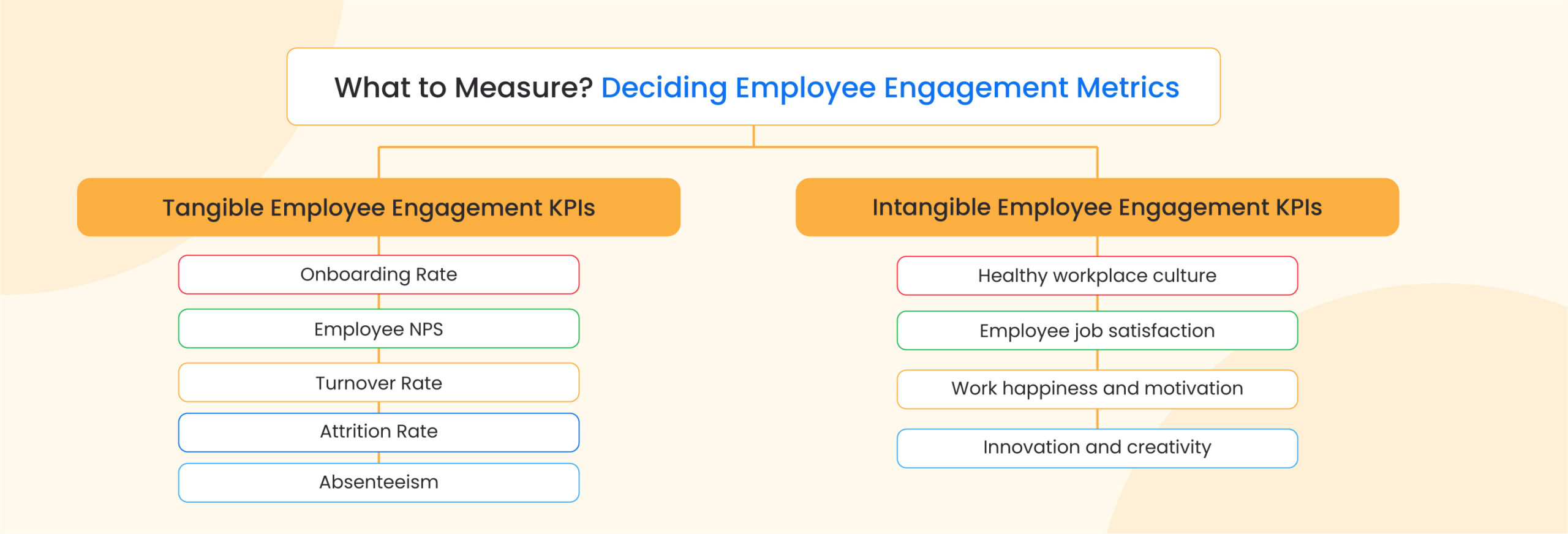
Your organization’s return on investment in onboarding, training, recruiting, and retaining can be measured in many ways. All you need is the list of right KPIs to measure your engagement levels and build an effective plan for future strategies. Below mentioned is the list of employee engagement metrics that can be used to measure ROI in terms of the business outcomes you seek.
Tangible employee engagement KPIs
Onboarding Rate
You have a few KPIs to measure the success of your recruitment initiative. Overall, when a new employee decides to stay after the “early hire” time period, this indicates that your organization is headed in the right direction in terms of identifying and engaging new employees.
Further, you can also measure the percentage of employees coming through internal referrals, this point indicates that your existing employees are happy with their work environment and wish to share it with their peers. Another HR metric to measure is the time to hire and new employee satisfaction with the onboarding rate. According to Leena AI’s State of the Onboarding Report, “41% of the respondents anticipate that they will adopt an automated onboarding process within the next 6 – 12 months”.
Employee NPS
One of the most popular and generalized KPIs to measure ROI is through Employee Net Promoter Score. This KPI indicates how likely an employee will refer your organization’s services and products to his friends and family. This method is a clear indicator of where your company’s work culture and services actually stand in the market. The core point is how willingly an employee would promote your services and products to their friends and family. This metric notably indicates how much the employee is engaged in and believes in what the organization is producing.
Turnover Rate
Employee turnover is defined as the number of employees who quit the organization, or, are asked to leave, and are replaced by new employees. Another notably quantifiable KPI is calculating the turnover rate of your employees. The calculation is very simple, divide the number of exited employees which includes all the resignations in a year by the total sum of active employees by the year-end, and multiply by 100. The remaining number will be your annual turnover percentage. With the help of this percentage, you can get a fair idea of how long your employees stay with your company and how often you have to replace them.
“Before investing and implementing an engagement plan, it’s critical to quantify the degree to which disengagement affects your business. At this point, quantifiable metrics come into play. In short, tracking key metrics every month will allow you to keep your finger on the pulse of engagement in your organization.”
Attrition Rate
The attrition rate is different from the turnover rate, here you calculate the number of employees who left the organization and did not get replaced. This calculation must include employees who left for better opportunities, unplanned retirements, resignations for personal reasons, and lay-offs. This number will indicate where your company stands in terms of retention and what measures you should take to make your employees stay.
The formula for calculating your employee attrition rate is by dividing the number of full-time employees who have left per month by the average number of employees and then multiplying that sum by 100. Another formula to calculate the number of engaged employees is by dividing the number of employees that stayed with your company through the turnover timeframe by the number of employees you started with on day one. Then, multiply that number by 100 to get your employee retention rate.
Absenteeism
Employee engagement level is quite evident with the number of employees who show up and add value to their work. This calculation can be done on a monthly basis in which you divide the number of unexcused absences in a given time period of time, divide it by the total time period, and multiply the sum by 100 to calculate the percentage.
Absenteeism within teams shows you whether there are certain managers or departments that need attention to improve the employee experience. Additionally, if certain employees are often absent without any valid reasons, this also affects the rest of the team members. However, presenteeism also does not guarantee engagement. Employees may arrive at work, but they aren’t actively engaged at the job. They might be distracted, or put in less effort than they should be. This is a strong indicator of declining engagement levels, and if it’s a team-wide issue, then the need to realign your company’s goals with that of your employees is a must.
Intangible employee engagement KPIs
Healthy workplace culture
It is very important for HRs to get an idea about the relationship between employees and their organization to encourage a healthy workplace culture. Understanding how the dynamics are vertically and horizontally across the organization provides insight to many intangible issues. An evaluation of the relationship between groups and teams, among individuals, and with the organization will help you understand the need for more team-building activities, one-on-one interactions, or recognition programs.
Employee job satisfaction
Employee satisfaction is something that makes the workplace a more enjoyable place to be. Happy, proactive, productive and committed employees contributing to the organization’s goals will increase your bottom line profits, create lower employee turnover and improve overall company performance and productivity.
Work happiness and motivation
Keeping your employees happy and motivated is key to performance and retention. Motivated employees work harder, better, and stay in their job positions longer. However, there is a possibility that you might be killing your employees’ motivation in ways that you are not even aware of. This includes overlooking internal promotion, not building a unique culture, not employing employee strengths properly, not respecting and recognizing employees for their accomplishments.
Innovation and creativity
A creative mindset is a must for understanding customers and their needs. Whether an employee is assigned with a new project or addressing customer service calls, their unique point of view can pave the way for org-wide improvement. Creative ideas can come from any individual, not necessarily from those with creative profiles. Unexpected creativity that pushes boundaries, disrupts tradition, and builds competitive advantage is vital for employee engagement and overall business success.
According to SHRM/Globoforce Survey, Organizations that rely on more frequent performance reviews are more likely to use peer feedback, either ongoing or intermittently (38 percent versus 27 percent). Additionally, 89 percent of HR leaders surveyed agree ongoing peer feedback and check-ins have a positive impact on their organizations.
What are the most commonly used tools for measuring employee engagement?

When employers are well aware of the technique for measuring employee engagement, they can deliver the best strategies to amplify their gains. Employee engagement tools are designed to measure and assess how motivated and engaged your employees are to work each day. These tools provide a peephole into the thoughts and attitudes of employees towards their work, each other, and their overall environment.
Here’s a list of the most common types of tools employed for measuring employee engagement:
Employee engagement surveys:
- Org-wide employee engagement surveys: An organization-wide survey aims to measure and benchmark the level of employee engagement across the organization. Gauging the engagement levels across the organization helps leaders and managers impact the performance of employees. Organization-wide surveys help provide a comprehensive view of an organization’s strengths, opportunities, and an understanding of what drives engagement. Beyond giving employees a voice, surveying employees about critical topics in the workplace can make them feel like they are an important part of the larger organizational outlook and mission.
- Pulse surveys: As the name suggests are more specific to a topic closely related to employees’ individual engagement levels. Pulse surveys should be shorter, with anywhere from 1 to 15 questions. The thumb rule is the more frequent the pulse, the shorter you should make it. These surveys can be easily rolled out online and you can receive data in real-time. Employee pulse surveys feature statistical analysis and trend graphs. Observing how responses were impacted post major or minor internal events, or during the times of change is a vital insight into building employee motivation and morale.
- Lifecycle surveys: Right from the entry of the employee to their exit, lifecycle surveys help in decoding all the moments irrespective of their magnitude. As employees progress through their tenure, there are many critical moments that impact engagement, performance, and retention. HRs must get visibility into these moments to improve their hiring, onboarding, training, and retention strategies. These surveys help you see what’s happening across the employee journey so you can optimize your employee experience and engagement strategies.
- Onboarding surveys: These new-hire surveys are key to building a long-term engagement among the new workforce. A thorough and updated onboarding strategy has a strong correlation with higher employee engagement, increased employee connection, and better clarity. Onboarding surveys ensure that the employees are aligned with their job role, the company’s overall business strategy, and believe in the company’s policies. This can include questions, about when they first heard about the company, their initial impressions, to their first few months in their new role. The feedback received from onboarding surveys will also allow you to upgrade your recruitment strategies.
- Exit surveys: Exit surveys help employers to build more attractive and fruitful work cultures so employees stay longer and feel more engaged. Set up some time to give employees who are leaving our expert-certified employee exit surveys and find out what you are doing right and where you might need more improvement. Exit surveys are key to understanding the reason for attrition in your organization.
360-Degree feedback tool
360-degree feedback is a system employed by organizations to provide honest, confidential, and anonymous feedback to coworkers. This feedback is employed significantly in building learning and development initiatives. A 360-degree feedback assessment evaluates an individual’s strengths and areas for improvement. Usually, this feedback is then reviewed by people in HR, a manager, or a coach.
People analytics tool
People analytics tools are the source of employee data for HRs to make effective and streamlined decisions. The tool allows HRs to explore correlation, and causation and make data-driven decisions about how to adjust or progress. With the help of business dashboards, maps, survey analysis, and time series analysis, HRs can measure employee engagement and performance levels, visualize ideal practices for management, and build a highly-engaged workforce.
Goal tracking tool
A goal tracking tool allows employees to check on their assignment progress and helps them self-monitor whether they are on track or not. The tool offers a framework for status updates, performance feedback, and feedback. Employees who possess a strong sense of direction tend to have higher job satisfaction and are more motivated to work which increases the rate of employee retention.
Voice of the employee tool
This tool gives employees a platform to express their opinions and provide feedback on any issue they face during their tenure. Backed by natural language processing and machine learning, this tool is a great way to bridge the gap between employees and the organization. With the help of AI-powered sentiment analysis techniques, HRs can gather feedback, identify employee turnover behavior, pin actions and take proactive steps on a single platform. The data received also provides the existing state of employee satisfaction in your company and can help in finding the root cause of the problems. Voice of The Employee tools generally are integrated with a question library designed by subject matter experts and can easily work on channels such as Slack, Teams, Whatsapp, and many more.
“Employees who are highly engaged have a strong sense of belonging to the company and to their customers. They are frequently brand advocates who are dedicated to developing long-term consumer relationships. According to research, businesses with highly engaged staff experience a 10% rise in customer metrics and a 20% gain in sales.” –
What does measuring employee engagement promise?
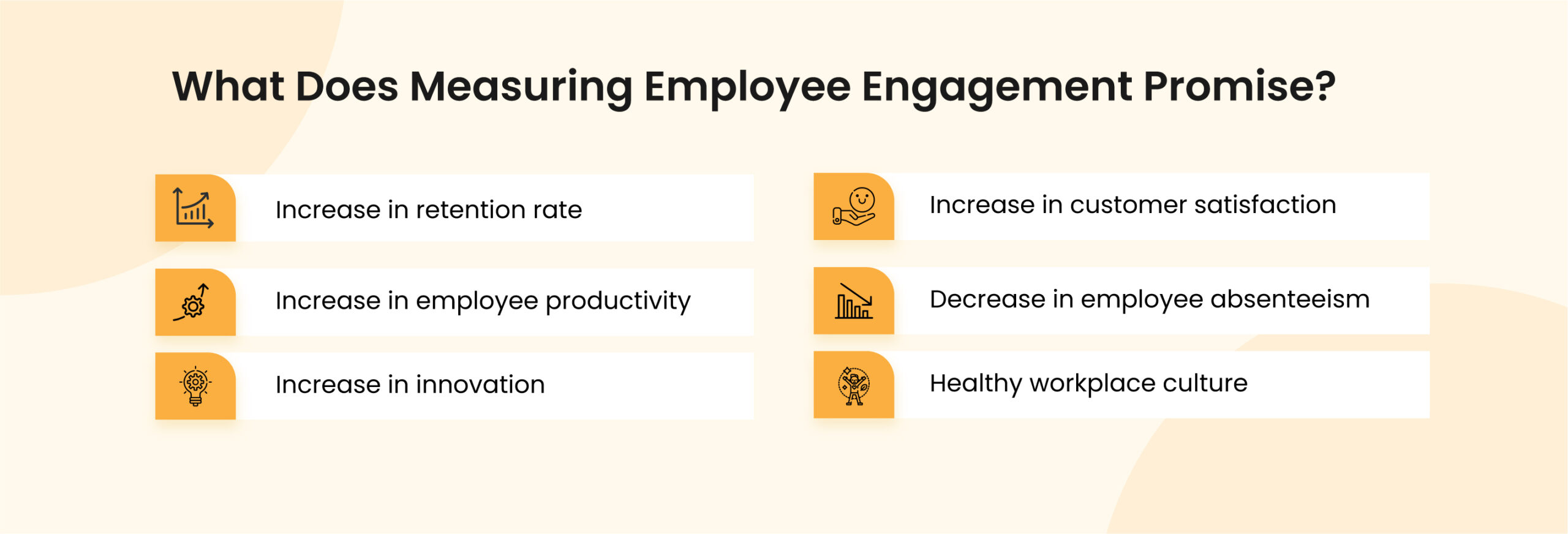
Engagement is defined by an employee’s personal investment in their work, organization, and the organization’s goals. This emotional state of engagement encourages employees to build connections that help organizations move forward. A satisfied workforce brings an organization to a static state and an engaged workforce allows the organization to move forward. Here’s what happens when you decide to build an engaged workforce.
-
Increase in retention rate
Employees who invest emotionally into their work and organization would always prefer to stay with their existing work environment rather than take up other opportunities. Increased employee engagement means increased productivity and increased revenues. Therefore, the success of engagement initiatives is not only defined by a boost in the numbers but also it is the most effective when your employees decide to keep working for your business rather than take up a new opportunity.
-
Increase in employee productivity
When employees attach emotion to their work, it results in them caring for it and constantly improving it for their own development. Feeling valued and cared for at work is the biggest motivation for employees. If they do not feel heard and a part of the company’s vision, they will automatically detach themselves emotionally and physically.
-
Increase in innovation
High engagement levels lead to employees constantly thinking about ways to improve their work and upgrade their skill set.
-
Increase in customer satisfaction
A highly engaged employee or a team understands the value of quality services/products very well and acts as the ambassador of the company when facing customers in the market.
-
Decrease in employee absenteeism
When your workforce is inherently motivated to work, you will need to lure them into the office by offering overtime pays or any kind of goodies.
-
Healthy workplace culture
When you measure the impact of your engagement activities, it will help in setting benchmarks that will further help in achieving your goal of building a healthier work environment. Measuring the effectiveness of your engagement activities provides a very clear estimate of what is working and what is not working for your organization.
“Employees who are highly engaged are more aware of faults and quality issues in their products or services. Quality faults were reduced by 40 percent in highly engaged business units.”
Immediate actions to take post gathering the feedback data
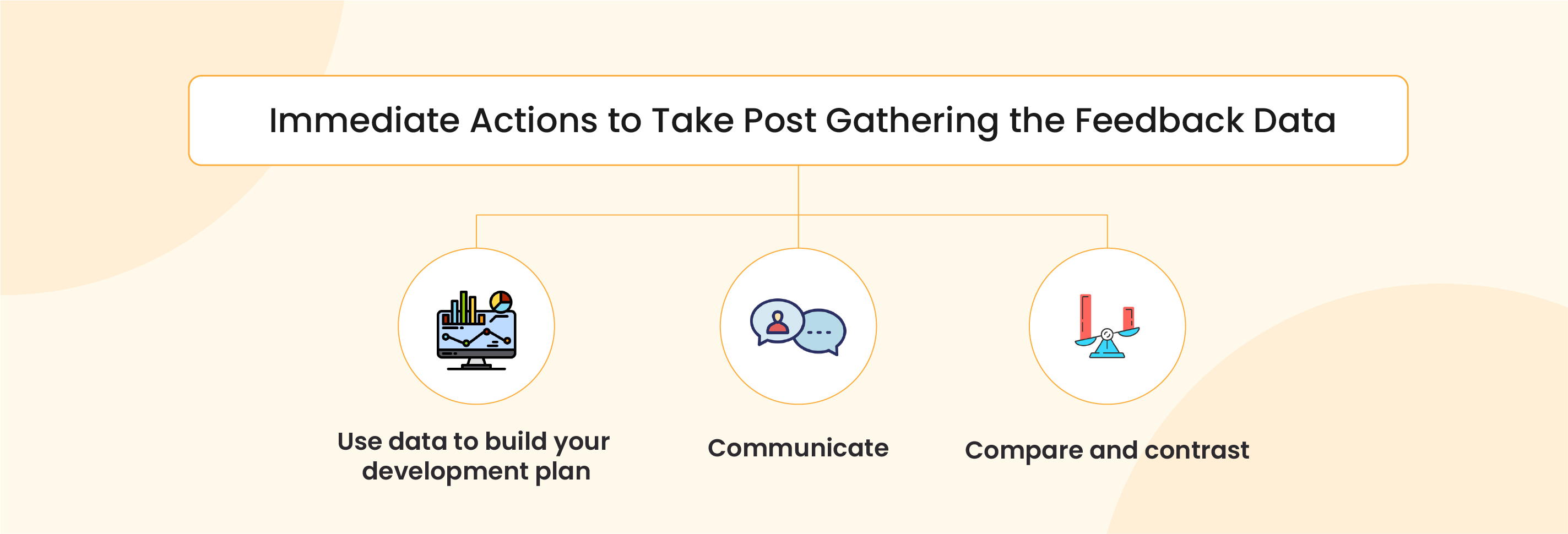
Three simple steps to conduct right after the implementation of your engagement plan:
1. Use data to build your development plan
The data received by employee engagement initiatives should be your pivot for bringing in the change. Observe the demographics scoring lower or higher than others and then with the help of sentiment analysis, you will be able to understand the reasons more clearly. Whether it is a small engagement activity or an organization-wide initiative to engage employees, your engagement strategies should only be justified by the data you have collected.
2. Communicate
Post conducting employee engagement activities, it is essential for HRs to communicate the result of the received feedback. This is an engagement activity itself as it engages employees by allowing them to feel heard and valued. This will eventually result in a high response rate in the future as employees will understand the value of taking part in these initiatives.
3. Compare and contrast
Once you have acted on the necessary changes that were the result of the engagement initiatives, it is time to run another survey. Keep an eye on the change in the numbers/scores and you can determine the success and failure of your engagement plan then and there. You can easily show the management that the initiatives you conducted were strategic and effective.
Employee Engagement & The Hybrid Workplace Report 2022
Download nowLeena AI: Your most trusted partner for conducting and measuring employee engagement
From employee help desk to employee engagement, process automation to employee insights, Leena AI helps you redefine every aspect of employee experience.
Leena Engage, Leena AI’s one-of-a-kind employee engagement platform, guarantees one of the highest participation rates in the market – as high as 90% – through a conversational AI and human-like experience.
Leena Engage empowers you to listen to your employees in a non-intrusive manner, have efficient data points at your fingertips, draw insights from a simple and streamlined dashboard, and put those insights to work.
Leena Engage is your one-stop-shop to turn insights into actions and actions to impact.
With Leena Engage, you can
- Listen to employee issues proactively, at an organizational level.
- Identify employees who are unhappy and unmotivated, and take timely actions.
- Reduce attrition and improve employee happiness.
- Be the pioneer in category-defining organizational culture. How do we do it?
- We run conversational, human-like, and short pulse surveys multiple times a year.
- Once we have the data, we automate data analysis and provide you with ready actionable dashboards.
- You see where the problems lie, which employees are unhappy and because of what. As simple as that.
- Within the same tool, you can even plan your actions and track progress.
Measuring employee engagement with Leena AI:
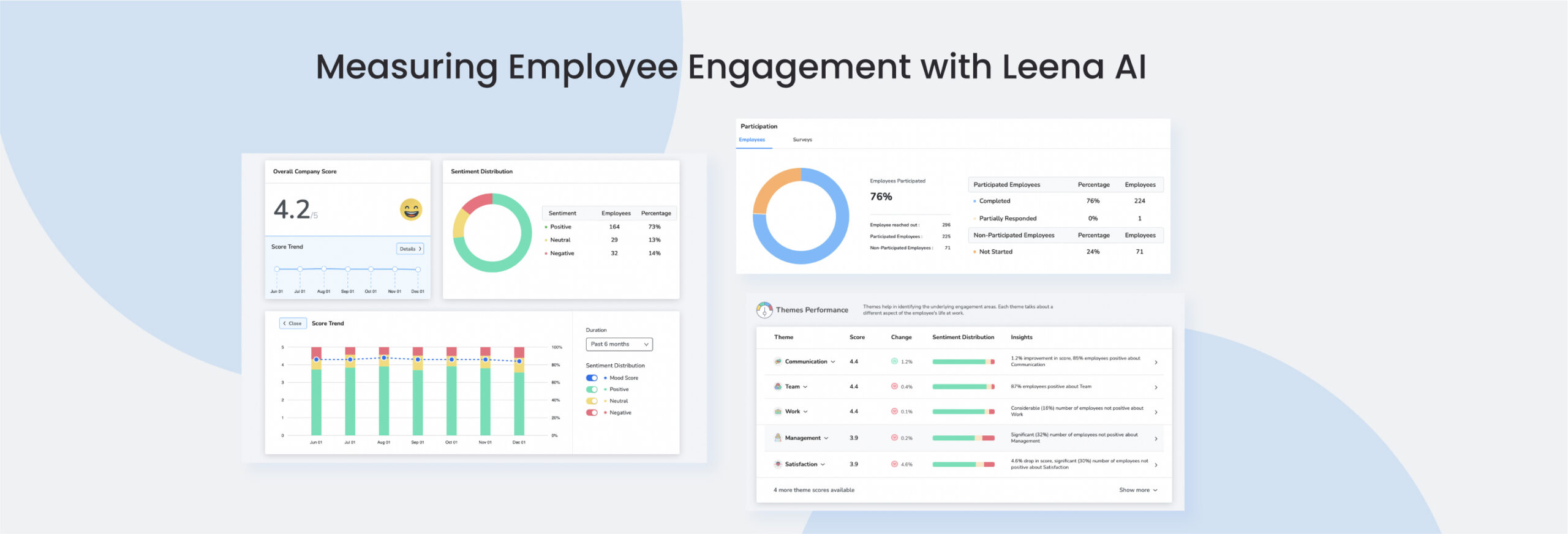
Key engagement drivers
Leena AI is trained to identify the key themes and sub-themes for your organization and how they impact employee engagement levels. It assigns different weightage to each theme and tells you which themes to focus on more. It automatically creates actions on insights that have the highest impact on employee engagement.
Sentiment analysis
Leena AI assigns sentiment scores to 7 primary themes and 48 sub-themes that primarily drive employee engagement. It gives you sentiment scores for each segment of your employees and helps you feel the pulse of your organization at the moment.
Text analytics
Leena AI is equipped with natural language processing and machine learning. It analyzes all open-text responses right after your employees take the survey. It, then, assigns sentiment scores to the topics and tells you what matters the most to your employees.
Action planning
Leena AI immediately identifies comments about critical aspects such as bias, harassment, etc. It flags them out for taking immediate corrective action.
Attrition prediction
Leena AI uses sentiment analysis and text analytics to identify employees who are unhappy and can leave the organization. It creates automatic action plans to retain those employees and empowers the leaders to minimize attrition.
Click here to know more about how to build an impactful employee engagement plan with Leena AI
The impact of Leena AI on your business
Leena Engage’s intelligent surveys and conversational interface ensure impactful and improved overall employee engagement and experience. According to our internal data, businesses have seen participation rates increase as high as 90% only by adopting Leena’s conversational interface.
With the help of Leena AI’s observed performance numbers, some calculations, and a few general assumptions, we lay down for you the impact you can create on your business by adopting Leena Engage’s intelligent tool. Keeping employee productivity, attrition, hiring, and absenteeism as the key metrics, below we calculate the total impact for three different sized enterprises.
Keeping our internal data and general reference points in consideration, we have made a few assumptions in terms of the numbers you can achieve by implementing Leena Engage:
- Leena AI on average reduces attrition by 2% due to improved engagement. However, we have taken the general estimate of 1%.
- On average, engaged employees increase productivity by at least 20%, according to multiple researchers. However, we have taken a conservative estimate of 5%.
- It is observed that engaged employees are less absent by ~40%. However, we have taken the conservative estimate of 10%.
- Generally, it takes around 4 months on average to hire a new person when an employee leaves.
- It takes time to onboard an employee before he starts providing value. It costs companies opportunity cost/time value to money. We’ve taken an assumption of 2 months here.
- Hiring cost per employee is about 10% of the annual salary at least.

Using the assumptions above, you can expect to see the following improvements in the areas of turnover, absenteeism, and productivity when you commit to boosting employee engagement at your organization with Leena Engage:
Impact on a start-up (less than 1000 employees):
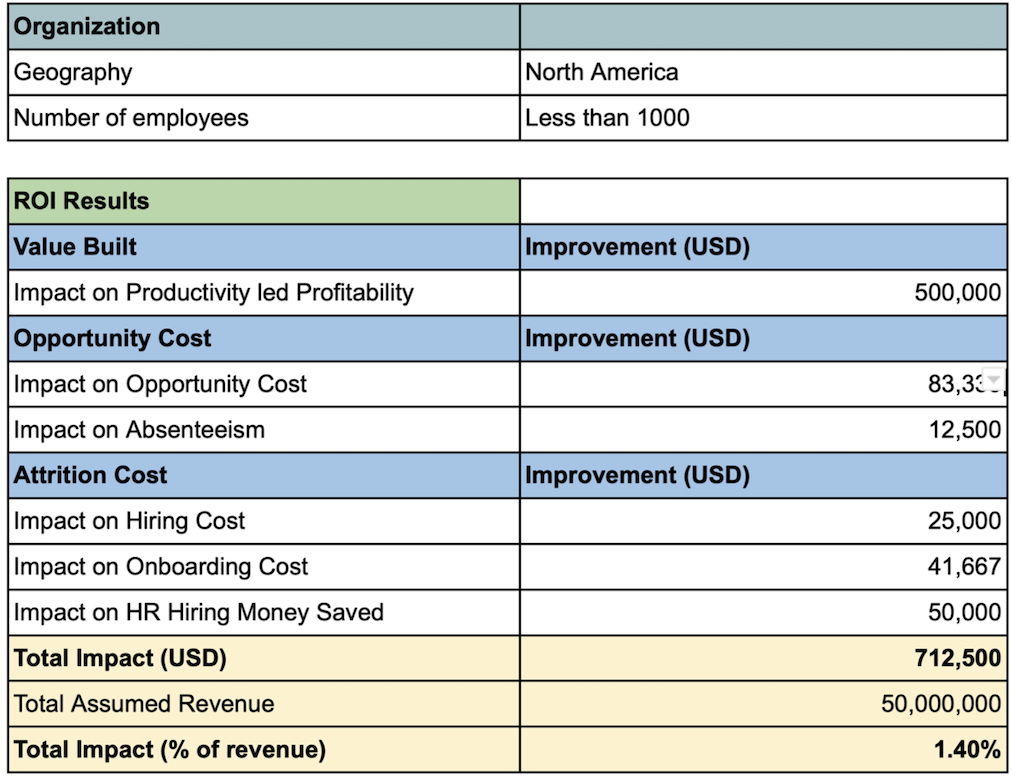
Impact on a mid-sized business (between 2000-5000 employees):
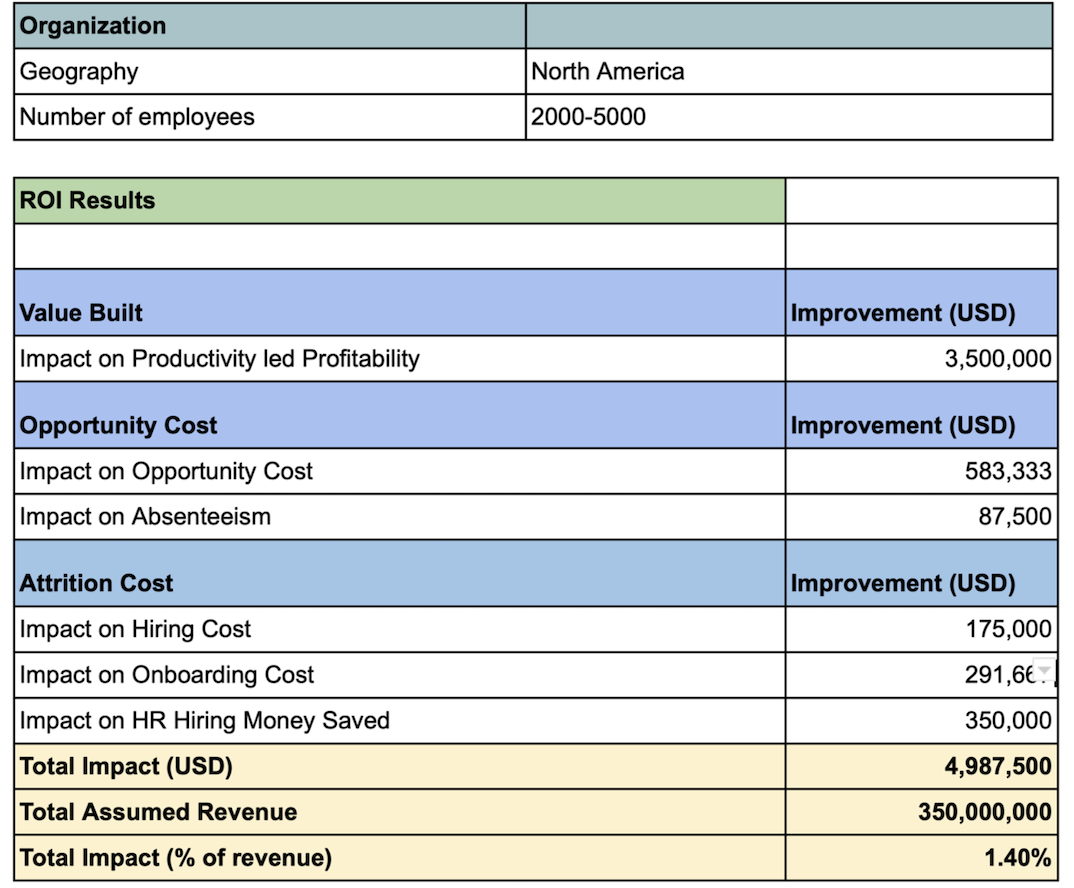
Impact on a large enterprise (More than 100000 employees):
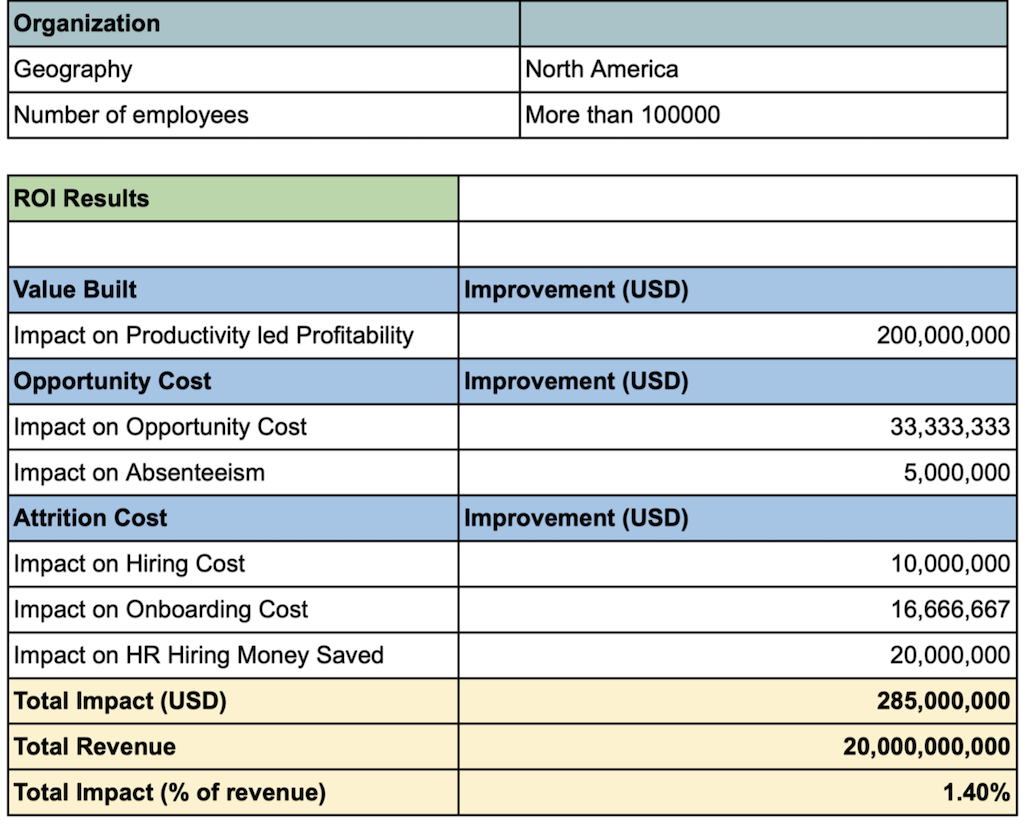
Build data-backed employee engagement plan
Calculate ROI Now!To sum up
There are multiple factors that contribute to employee engagement – from work culture to management style, from work-life balance to finding purpose in one’s work – and these factors are personal for each employee. This complexity is what makes it so challenging to measure and understand engagement in an actionable manner.
Given the many potential levers of employee engagement, the challenge for leaders is to combine theory and data to understand which levers should be prioritized in their workplace context.
However, people analytics has begun to provide organizations with the right tools and data to drive engagement, maybe even better than employees understand themselves.
Calculating the ROI of employee engagement with the right set of tools will allow HRs to make data-backed decisions and justify their actions and strategies. Employee engagement quantification has multiple levels and each level caters to the benefit of the organization, employees, HRs, and management, respectively.
If you are looking for a partner to provide you with a robust platform to amplify your employee engagement game and help in measuring employee engagement accurately, check out Leena AI’s engagement surveys that offer multifold solutions backed by stellar technology.
Looking for AI-powered employee engagement solutions?
Schedule a demo nowFrequently Asked Questions
What is the ROI of employee engagement?
The ROI of employee engagement is defined by the calculation of how much monetary loss occurred through disengaged employees and how much monetary gain can happen by engaging or re-engaging employees.
What are the benefits of measuring Employee Engagement?
The benefits of measuring employee engagement are multifold:
- Increase in retention rate
- Increase in employee productivity
- Increase in innovation
- Increase in customer satisfaction
- Decrease in employee absenteeism
What are the most commonly used tools for measuring employee engagement?
Here’s a list of the most common types of tools employed for measuring employee engagement:
- Employee Engagement Surveys
- 360 Degree Feedback Tool
- People Analytics Tool
- Goal Tracking Tool
- New-age AI-powered/voice of the Employee Tool
What are the immediate actions to take post measuring employee engagement?
The immediate actions to be taken post-measuring employee engagement are
- Use the data received to build your future development and engagement plans
- Communicate the result of the received feedback.
- Keep an eye on the change in the numbers/scores and you can determine the success and failure of your engagement plan.
What are the metrics for measuring employee engagement?
Below mentioned is the list of employee engagement metrics that can be used to measure ROI in terms of the business outcomes you seek.
Tangible Employee Engagement KPIs
- Onboarding rate
- Employee NPS
- Turnover rate
- Attrition rate
- Absenteeism
Intangible Employee Engagement KPIs
- Healthy workplace culture
- Employee job satisfaction
- Work happiness and motivation
- Innovation and creativity
What are the fundamental KPIs of measuring employee engagement?
The fundamental KPIs of measuring employee engagement are:
- Onboarding Rate
- Employee NPS
- Turnover Rate
- Attrition Rate
- Retention Rate
- Absenteeism
What are the disadvantages of not measuring employee engagement?
The disadvantages of not measuring employee engagement are:
- Failed engagement initiatives
- Loss of cost, time, and resources
- Lack of skill development
- Higher attrition rate
- Miscommunication between management & employees
- Undervalued and demotivated Workforce
- Decrease in revenue numbers






